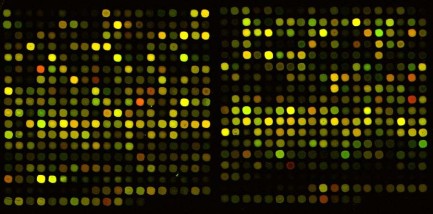As human population grows, disease-causing genetic mutations per individual increase, but each mutation is less harmful, when compared with a population that is not growing, says a Cornell study to be published in November in the journal Genetics.
The study also reports that natural selection has efficiently removed the most harmful genetic mutations, called very deleterious mutations, from the population and has removed a higher fraction of such mutations per generation.
The researchers used computer simulations to predict the role of natural selection on human genetic architecture in the face of rapid population rise. With advances in agriculture, public health, medicine and technology, human populations have soared in the last 500 years from around half-a-billion in 1500 A.D. to more than 7.1 billion today.
The findings have important implications for genetic and personalized medicine: For every disease-causing gene, there may be many slightly altered forms of that gene, called alleles, from one person to the next. This knowledge may point researchers to look for different alleles for the same disease.
“If you know that you have more deleterious variations in the population, then you know, on average, two people will likely have different variants” of the same disease-causing gene, said Elodie Gazave, the study’s lead author and a postdoctoral researcher in plant breeding and genetics. Gazave is a former postdoctoral researcher in the lab of Alon Keinan, a senior author of the study and the Robert N. Noyce Assistant Professor in Life Science and Technology in the Department of Biological Statistics and Computational Biology.
These finding may provide insights for researchers searching for genes that cause disease. Though people have invested millions of dollars to explain diseases and their relationship to genes, progress has been slow, Gazave said. For example, 81 percent of schizophrenia cases are thought to have a genetic basis, and yet researchers have only identified a genetic source in 1 percent of those cases. Mostly, researchers use an associational method for identifying common variants of disease; they identify an allele that causes a disease and they look for that same allele in other people with the disease, but mostly they fail to locate it.
Based on the finding that there are more alleles for each gene, Gazave suggests it may serve better to develop a mapping method that looks for alleles on chromosomal regions known to house a disease-causing gene.
“If we know what we are looking for then we are maybe more likely to find it,” Gazave said.
The most-asked question regarding such population genetics studies is whether people are becoming less healthy or fit based on the findings. The researchers measured fitness and found that the two main results – that there are more mutations, but each mutation is less deleterious – “exactly balance out,” Gazave said.
“Explosive [population] growth affects a lot of things, but eventually the fitness is not affected,” Gazave said.
Co-authors include Diana Chang, a graduate student in Keinan’s lab, and Andrew Clark, the Jacob Gould Schurman Professor of Population Genetics and the Nancy and Peter Meinig Family Investigator.
The study is funded by the National Institutes of Health, the Cornell Center for Comparative and Population Genomics, the Ellison Medical Foundation, the Alfred P. Sloan Foundation and the Edward Mallinckrodt Jr. Foundation.


